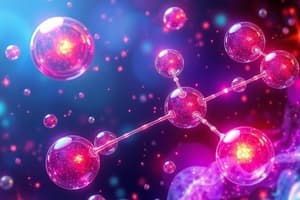Podcast
Questions and Answers
Rank the indicated protons in terms of most acidic to least acidic from the following options.
Rank the indicated protons in terms of most acidic to least acidic from the following options.
- Most acidic: Induction, Middle: Resonance, Least acidic: Atom
- Most acidic: Resonance, Middle: Atom, Least acidic: Induction (correct)
- Most acidic: Induction, Middle: Atom, Least acidic: Resonance
- Most acidic: Atom, Middle: Induction, Least acidic: Resonance
Which of the following statements accurately explains the ranking of OH vs. NH in terms of acidity?
Which of the following statements accurately explains the ranking of OH vs. NH in terms of acidity?
- O is less electronegative than N, making OH weaker.
- The atom effect indicates that O more electronegative makes OH stronger. (correct)
- Resonance effect favors NH over OH.
- The charge effect favors NH over OH based on electron distribution.
In a Bronsted-Lowry acid-base reaction, what do you look for when predicting the products?
In a Bronsted-Lowry acid-base reaction, what do you look for when predicting the products?
- The presence of inert gases
- Temperature effects on reactant states
- The concentration of reactants only
- The strength of the acids and bases involved (correct)
What is the IUPAC name for 4-ethyl-2-methylhexane?
What is the IUPAC name for 4-ethyl-2-methylhexane?
Which factor has lesser importance in determining the strength of acidity among these options?
Which factor has lesser importance in determining the strength of acidity among these options?
Flashcards are hidden until you start studying
Study Notes
Ranking Acidity
- CARIO effects help determine acidity:
- Atom: More electronegative atoms make an acid stronger.
- Resonance: More resonance stabilization of the conjugate base makes an acid stronger.
- Induction: Electron-withdrawing groups increase acidity by stabilizing the conjugate base.
- Charge: A more positive charge makes an acid stronger.
- Orbital: Hybridization affects acidity. sp orbitals are more acidic than sp2, which are more acidic than sp3.
Acid-Base Reactions
- Brønsted-Lowry acid-base reactions involve the transfer of a proton (H+).
- Stronger acids donate protons more readily.
- Weaker acids hold onto protons more tightly.
Organic Molecules
- Nomenclature follows IUPAC rules:
- Parent chain: The longest continuous carbon chain.
- Substituents: Groups attached to the parent chain.
- Numbers: Locate substituents on the parent chain.
Studying That Suits You
Use AI to generate personalized quizzes and flashcards to suit your learning preferences.





